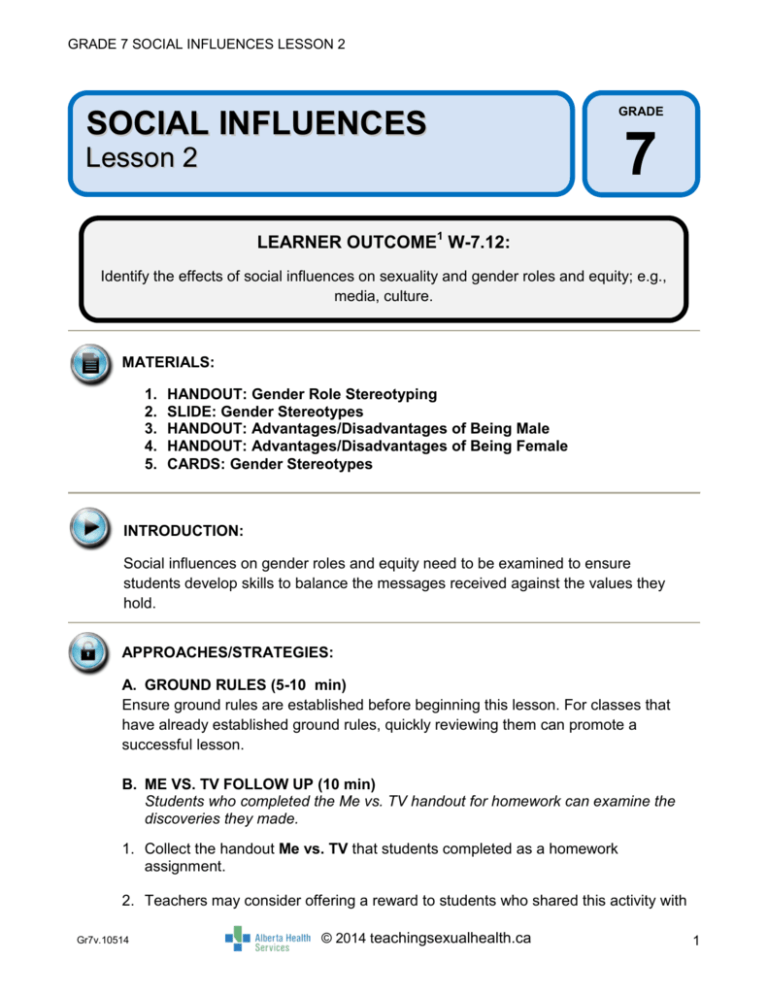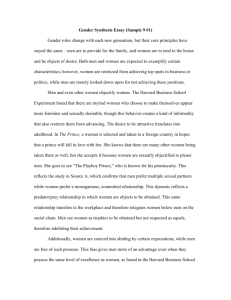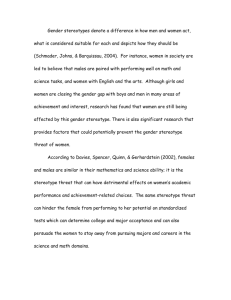social influences - teachingsexualhealth.ca
advertisement

GRADE 7 SOCIAL INFLUENCES LESSON 2 SOCIAL INFLUENCES Les s on 2 GRADE 7 LEARNER OUTCOME1 W-7.12: Identify the effects of social influences on sexuality and gender roles and equity; e.g., media, culture. MATERIALS: 1. 2. 3. 4. 5. HANDOUT: Gender Role Stereotyping SLIDE: Gender Stereotypes HANDOUT: Advantages/Disadvantages of Being Male HANDOUT: Advantages/Disadvantages of Being Female CARDS: Gender Stereotypes INTRODUCTION: Social influences on gender roles and equity need to be examined to ensure students develop skills to balance the messages received against the values they hold. APPROACHES/STRATEGIES: A. GROUND RULES (5-10 min) Ensure ground rules are established before beginning this lesson. For classes that have already established ground rules, quickly reviewing them can promote a successful lesson. B. ME VS. TV FOLLOW UP (10 min) Students who completed the Me vs. TV handout for homework can examine the discoveries they made. 1. Collect the handout Me vs. TV that students completed as a homework assignment. 2. Teachers may consider offering a reward to students who shared this activity with Gr7v.10514 © 2014 teachingsexualhealth.ca 1 GRADE 7 SOCIAL INFLUENCES LESSON 2 a parent or supportive adult. 3. Debrief questions include: • What were some of the major differences between your lives and the lives portrayed on TV? Similarities? • Do the messages about sexuality sent by TV match your values? Why or why not? • If you were given an opportunity to create a sitcom that would reflect your life, what would it look like? C. STEREOTYPING EXERCISE (10 -15 min) Students examine common stereotypes. 1. Distribute the Gender Role Stereotyping handout. 2. Have students complete the handout. 3. Ask the class to answer the following questions: How can we define “stereotype”? • • A stereotype is a belief that can be held by anybody about specific types of people or certain ways of doing things that may or may not accurately reflect reality. More often than not stereotypes are negative. A gender stereotype is something that people think is true about how others look, act, think, talk or feel because they belong to a certain gender. There are specific meanings associated with acting like a man and acting like a woman. What does it feel like to be stereotyped? Why? • • • 4. 5. 6. 7. Gr7v.10514 Stereotypes limit our potential. This is not to say that males shouldn’t fix cars and that females shouldn’t cook. The problem is that we are told that we must perform these roles in order to fit in. It is important for all of us to make our own decisions about who we are, what we do, and how we relate to others. Usually negative. You aren’t being seen the way you really are. You are being judged by what someone else thinks. Display the Gender Stereotypes slide. Ask volunteers to read each stereotype from the slides. Ask the class to volunteer other examples of gender stereotypes. Debrief this activity using the following questions: • How do stereotypes make you feel? • What are ways we can change these stereotypes? © 2014 teachingsexualhealth.ca 2 GRADE 7 SOCIAL INFLUENCES LESSON 2 D. ADVANTAGES/DISADVANTAGES (10 min) Students examine the differences that exist between males and females. 1. Distribute the Advantages/Disadvantages (male and female) handouts randomly within the class, giving half the class the male handout, and half the class the female handout. 2. Use “Think-Pair-Square” small groups to complete the handout. Give students time to list advantages and disadvantages independently. After a period of time, ask students to pair up with another student who has the same gender handout as they do. Have them share their lists. Once this is complete, have the pairs join another pair (same gender), and share lists again. 3. Debrief this activity using the following questions: • What are the advantages of being a male? A female? • What are the disadvantages of being a male? A female? • What similarities exist between males and females? • What differences exist between males and females? • Why do you think people, society and the media portray or have different ideas about males and females? Print Advantages /Disadvantages (male and female) handouts on different coloured paper. Be sensitive to the fact that some students may or may not identify as male or female. For more information about gender identity please visit: http://library.catie.ca/p df/ATI20000s/26289E.pdf E. GENDER STEREOTYPES (20 min) Students examine how gender roles affect the ways people deal with themselves and others. Students will identify how gender roles vary over time. 1. Divide students into six groups. 2. Distribute the scenario cards Gender Stereotypes. 3. Ask each group to discuss the following questions using their scenario: • How would you react to this situation now? • How do you think people will react 20 years from now? 4. Ask each group to assign a spokesperson who can read the scenario to the class and briefly share the group’s discussion. 5. Debrief this activity using the following questions: • What do you think the main differences will be between how we react to situations today versus how people might react in 20 years? Gr7v.10514 © 2014 teachingsexualhealth.ca 3 GRADE 7 SOCIAL INFLUENCES LESSON 2 • • • • • How can we explain the different ways people react to the same situations over time? Do males and females react differently? Why? Are gender roles changing? If you were a member of the opposite gender, what opportunities would you have that you feel you don’t have right now? What can we do to change the stereotypes? QUESTION BOX (10 min) Have students fill out questions and address them next class. SELF REFLECTION During the lesson, were: • • Ground rules being followed? Good practices established regarding group work and discussion? What will you change for future classes with this group? What will you change for future use of this lesson? STUDENT ASSESSMENT During the lesson, did students: Knowledge: • • • Define gender stereotypes? Identify common gender stereotypes? Identify differences and similarities that may exist between males and females? Skills: • • • Describe how gender roles change over time? Examine how gender roles affect the ways people deal with themselves and others? Develop strategies to react to situations that reinforce gender stereotypes? Attitudes: • Gr7v.10514 Accept responsibility for challenging and changing negative gender stereotypes? © 2014 teachingsexualhealth.ca 4 GRADE 7 SOCIAL INFLUENCES LESSON 2 1. Alberta Education. (2002). Health and life skills guide to implementation: Kindergarten to grade 9. Retrieved from http://www.education.alberta.ca/media/352993/pos.pdf Gr7v.10514 © 2014 teachingsexualhealth.ca 5 GRADE 7 SOCIAL INFLUENCES LESSON 2 HANDOUT Name:_______________________________ GENDER ROLE STEREOTYPING Quickly read through each statement and put a mark (√) in the box that best fits your opinion. Your choices are Strongly Agree, Agree, Disagree, and Strongly Disagree. SA A D SD 1. It's really the females job to stay home and raise the kids. 2. Females should be able to ask males out. 3. Males’ athletics are really more important than females’ athletics. . 4. Males make good secretaries and nurses. 5. Males should hide their feelings if at all possible. 6. If a husband and wife both work, they should both help with the cooking and cleaning at home. 7. Females have more feelings than males. 8. Males are really more intelligent than females. 9. The husband should have the final say. 10. It's just as OK for males to cry as for females. 11. Females should help pay for dates. 12. Education is more important for males than for females. 13. Females make good construction workers and engineers. 14. Males sometimes treat females like objects. 15. Males should learn how to cook, sew, clean house and do laundry. Gr7v.10514 © 2014 teachingsexualhealth.ca 1 GRADE 7 SOCIAL INFLUENCES LESSON 2 SLIDE GENDER STEREOTYPES Many people assume that because you are a male or female you should look, dress, act, talk and even think and feel certain ways. For example: Females are meant to be housewives when they grow up, not doctors or lawyers Real males don’t cry Females who are skinny are sexier Females who wear skimpy clothes are looking for sex Males who have big muscles are sexier None of the above is true…this is just what some people think! Every one is unique, and has different dreams and goals in their life. Gr7v.10514 © 2014 teachingsexualhealth.ca 1 GRADE 7 SOCIAL INFLUENCES LESSON 2 CARDS ADVANTAGES/DISADVANTAGES List as many advantages and disadvantages of being female that you can think of. ADVANTAGES: DISADVANTAGES: Gr7v.10514 © 2014 teachingsexualhealth.ca 1 GRADE 7 SOCIAL INFLUENCES LESSON 2 CARDS ADVANTAGES/DISADVANTAGES List as many advantages and disadvantages of being male that you can think of. ADVANTAGES: DISADVANTAGES: Gr7v.10514 © 2014 teachingsexualhealth.ca 1 GRADE 7 SOCIAL INFLUENCES LESSON 2 CARDS STEREOTYPE ONE Mike is about to ask a girl, Laura, out for the first time. He plans to go out for pizza and then go to a movie. Mike’s not sure if he should offer to pay her way on their date, or if he should just assume they’ll split the costs between them. What should he do? Discuss the following two questions: • • How would you react to this situation now? How do you think people will react 20 years from now? STEREOTYPE TWO Nicki is babysitting a little boy named Ramone, age 6. Ramone has decided that a Barbie doll that a visiting cousin left behind is his favourite toy. Nicki is a little concerned about Ramone’s choice of toys. Discuss the following three questions: • • • What should she do? How would you react to this situation now? How do you think people will react 20 years from now? STEREOTYPE THREE Janice has been interested in Rick for the last few months. She thinks he might like her, but he seems too shy to ask her out. She thought about calling him and asking him to go to the hockey game Saturday night, but she’s afraid of being pushy. She wants to go out with him. What should she do? Discuss the following two questions: • • How would you react to this situation now? How do you think people will react 20 years from now? Gr7v.10514 © 2014 teachingsexualhealth.ca 1 GRADE 7 SOCIAL INFLUENCES LESSON 2 CARDS STEREOTYPE FOUR Your 13-year old brother Dave is very interested in dancing. He just found out that the physical education department is going to offer modern dance class next semester. He really wants to take the class, but knows he probably will be the only guy in the class and thinks he’ll feel funny. What do you say? Discuss the following two questions: • • How would you react to this situation now? How do you think people will react 20 years from now? STEREOTYPE FIVE Your best friend, Alex, wants to go to nursing school after he graduates from high school. How do you feel about his career choice? Discuss the following two questions: • • How would you react to this situation now? How do you think people will react 20 years from now? STEREOTYPE SIX Your sister Carrie loves to play hockey and has played with you and your friends for years. She is just entering high school and wants to try out for the school team. Carrie says she will sue if the school doesn’t let her try out. What do you think? Discuss the following two questions: • • Gr7v.10514 How would you react to this situation now? How do you think people will react 20 years from now? © 2014 teachingsexualhealth.ca 2








